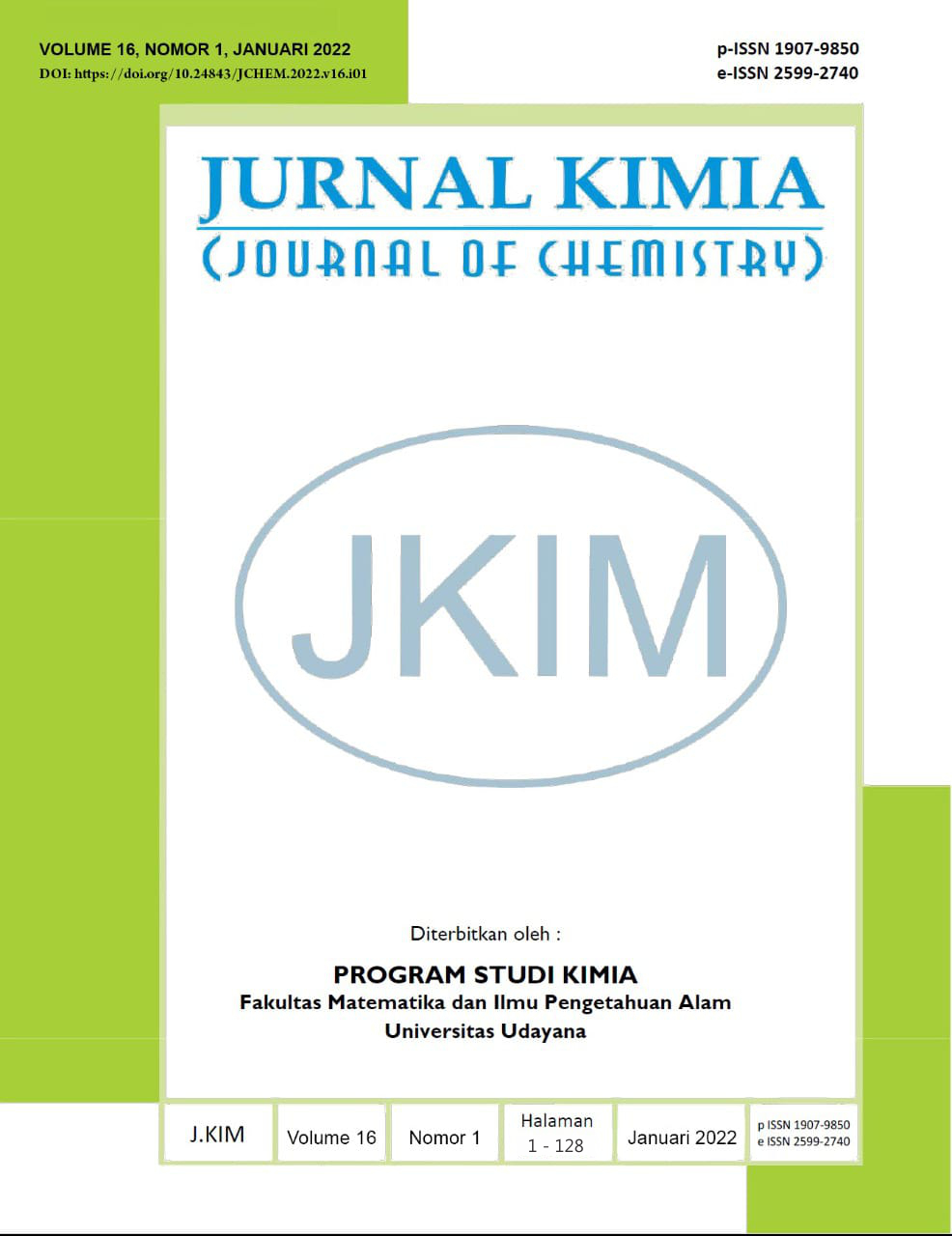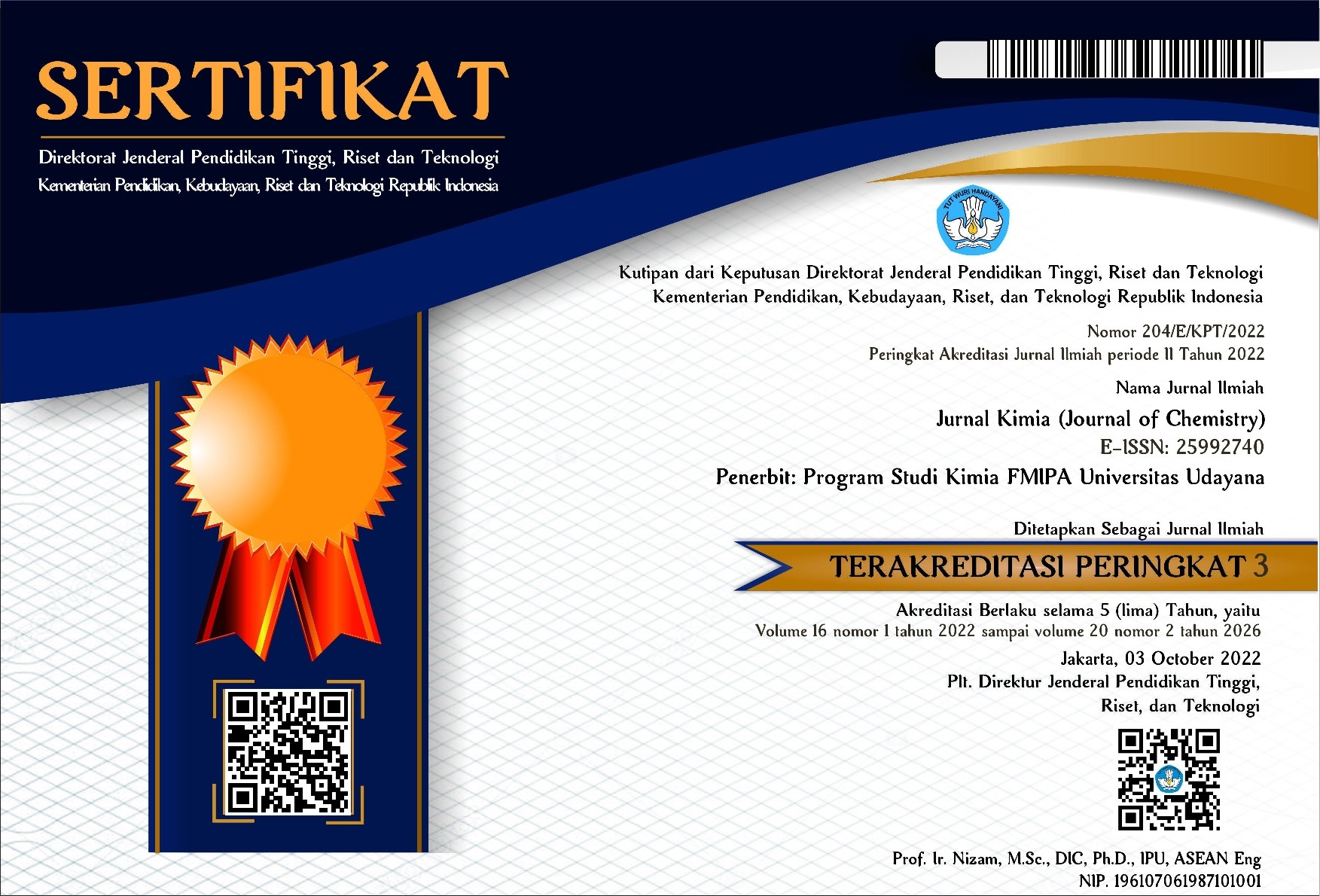PENENTUAN KONDISI OPTIMUM KROMATOGRAFI CAIR KINERJA TINGGI UNTUK PEMISAHAN ASAM LEMAK HIDROKSAMIK BERBASIS MINYAK INTI BUAH KETAPANG
Abstract
Sintesis Asam Lemak Hidroksamik (ALH) telah dilakukan dengan mereaksikan minyak inti buah ketapang dan hidroksilamina secara enzimatis menggunakan lipase terimobilisasi (Lipozyme TL IM). ALH yang didapatkan masih berupa campuran asam-asam lemak penyusun trigliserida minyak inti buah ketapang. Tujuan dari penelitian ini untuk mengetahui kondisi optimum pemisahan campuran ALH menjadi komponen tunggalnya serta persentase komposisinya menggunakan Kromatografi Cair Kinerja Tinggi (KCKT). Kolom, detektor, dan panjang gelombang yang digunakan saat analisis masing-masing adalah kolom fase terbalik (reverse phase) SunFire C18 5 µm 4,6 x 150 mm, detektor Ultra Violet (UV), dan panjang gelombang 213 nm. Kondisi optimum pemisahan ALH yang diperoleh yaitu fase gerak metanol 100%, laju alir 0,25 mL/menit, konsentrasi sampel 10.000 ppm dan volume injeksi sampel 20 µL. Komposisi asam-asam lemak hidroksamik yang berhasil dipisahkan adalah asam palmitil hidroksamik (13-14%), asam stearil hidroksamik (3-4%), asam oleil hidroksamik (25-26%), dan asam linoleil hidroksamik (59-60%).
Kata Kunci: asam lemak hidroksamik, minyak ketapang, KCKT, lipozyme.
Fatty Hydroxamic Acid (FHA) synthesis was carried out by reacting ketapang kernel oil and hydroxilamine enzymatically using immobilized lipase enzymes (Lipozyme TL IM). The FHA obtained is still in the form of a mixture of fatty acids that make up the triglycerides of the ketapang kernel oil. The purpose of this study was to determine the optimum conditions for the separation of FHA mixture into its single component and the percentage of its composition using High Performance Liquid Chromatography (HPLC). Column, detector, and wavelength used in the analysis were SunFire C18 5µm 4.6 x 150 mm reverse phase column, Ultra Violet (UV) detector, and 213 nm wavelength. The optimum conditions for FHA separation were 100% methanol mobile phase, 0.25 mL/minutes flow rate, 10.000 ppm sample concentration, and 20 µL sample injection volume. The composition of the hydroxamic fatty acids that were successfully separated were palmithyl hydroxamic acid (13-14%), stearyl hydroxamic acid (3-4%), oleyl hydroxamic acid (25-26%), and linoleyl hydroxamic acid (59-60%).
Keywords: fatty hydroxamic acid, ketapang oil, HPLC, lipozyme.
Downloads
References
Bakhtra, D. D., Rusdi, dan Mardiah, A. 2016. Penetapan Kadar Protein dalam Telur Unggas Melalui Analisis Nitrogen Menggunakan Metode Kjeldahl. Jurnal Farmasi Higea. 8(2): 143-150.
Carvalho, M. S., Mendonca, M. A., Pinho, D. M. M., Resck, I. S., dan Suarez, P. A. Z. 2012. Chromatographic Analyses of Fatty Acids Methyl Esters by HPLC-UV and GC-FID. J. Braz Chem Soc. 23(4): 763-769.
Chance, J. P., Fejzic, H., Hernandez, O., Istvan, E. S., Andaya, A., Maslov, N.,dan Goldberg, D. E. 2018. Development of Piperazine-based Hydroxamic Acid Inhibitors Against Falcilysin, an Essential Malarial Protease. Bioorganic & Medical Chemistry Latters. 28(1): 1846-1848.
Dolowy, M., dan Pyka, A.. 2015. Chromatographic Methods in the Separation of Long-Chain Mono- and Polyunsaturated Fatty Acids. Journal of Chemistry. 1-20.
Hoidy, W.H., Ahmad, M.B., Al-Mulia, E. A. J., Yunus, W. M. Z. W., dan Ibrahim, N. A. B. 2010. Synthesis and Characterization of Fatty Hydroxamic Acids from Triacylglycerides. Journal of Oleo Science. 59 (1): 15-19.
Iha, O.K., Alves, F. C. S. C., Suarez, P.A.Z., Silva, C. R. P., Meneghetti, M. R., dan Meneghetti, S. M. P. 2014. Potential Application of Terminalia catappa L. and Carapa guianensis Oils for Biofuel Production: Physical-Chemical Properties of Neat Vegetable Oils, Their Methyl-esters and Bio-oils (Hydrocarbons). Industrial Crops and Products. 52: 95-98.
Jafar, B. M., Hamadneh, I., Khalili, F. I., dan Al-Dujaili, A. H. 2015. Kinetic Study on Adsorption of Faty Hydroxamic Acids by Natural Clays. Jordan Journal of Earth and Environmental Sciences. 7(1): 11-17.
Jahangirian, H., Haron, M. J., Yusof, N. A., Silong, S., Kassim, A., Raflee-Moghaddam, R., dan Gharayebi, Y. 2011. Enzymatic Synthesis of Fatty Hydroxamic Acid Derivatives Based on Palm Kernel Oil. Molecules. 6634-6644.
Kembaren, A., dan Harahap, T. 2014. Validasi Metode Penentuan Sakarin Menggunakan Kromatografi Cair Kinerja Tinggi. Jurnal Pendidikan Kimia. 70-80.
Majeewski, M. W., Cho, S., Miller, P. A., Franzblau, S. G., dan Miller, M. J. 2015. Syntheses and Evaluation of Subtitued Aroamtic by Hydroxamates and Hydroxamic Acids that Target Mycobacterium Tuberculosis. Bioorganic & Medicinal Chemistry Letters. 1-4.
Mayer Bernard X., Neckel U., Jauhcahadar C., Frossard M., Jager W., dan Muller M. 2002. Simultaneos Determination of Levofloxatin and Ciprofloxxacin in Microdialysates and Plasma by High-Performance Liquid Chromatography. Analytica Chemica Acta. 199-206.
Murniati, Suhendra, D., Gunawan, E. R., Handayani, S. S., Kurniawati, L., dan Ayuliansari, Y. 2019. Identifikasi dan Isolasi Asam Lemak Essensial Ekstrak Minyak Belut Menggunakan Kromatografi Cair Kinerja Tinggi. Orbital Chemistry Journal. 1(1): 12-19.
Najem, S. A., Khawaja, G., Hodroj, M. H., Babikian, P., dan Rizk, S. 2019. Adjuvant Epigenetic Therapy of Decitabine and Suberoylanilide Hydroxamic Acid Exerts Anti-Neoplastic Effect in Acute Myeloid Leukimia Cells. Cells. 8: 1-23.
Nam, N., Huong, T. L., Dung, D. T. M., Dung, P. T. P., Oanh, D. T. K., Quyen, D., Thao, L. T., dan Park, S. H. 2013. Novel Isatin-based Hydroxamic Acids as Histone Deacetylase Inhibitor and Antitumor Agents. European Journal of Medicinal Chemistry. 70: 477-486.
Stranix, B. R., Wu, J. J., Milot, G., Beaulieu, F., Bouchard, J.-E., Gouveia, K., dan Xiao, Y. 2016. Pyridoxine Hydroxamic Acids as Novel HIV-integrase Inhibitors. Bioorganic & Medicinal Chemistry Letters. 1-4.
Suhendra, D., Yunus, W. M. Z. W., Haron, M. J., Basri, M., dan Silong, S. 2005. Enzymatic Synthesis of Fatty Hydroxamic Acids from Palm Oil. Journal of Oleo Science. 54 (1): 33-38.
Suhendra, D., dan Gunawan, E. R. 2012 Sintesis Asam-Asam Lemak Hidroksamik dari Minyak Kelapa Menggunakan Lipase sebagai Katalis. Jurnal Natur Indonesia. 14(2): 160-164.
Suhendra, D., Gunawan, E. R., Yuanita, E., dan Nazili, M. 2018. Optimization of Lipase-Catalyzed Synthesis of Fatty Hydroxamic Acid from Terminalia Catappa L. Kernel Oil. Oriental Journal of Chemistry. 34(5): 2370-2377.
Zhou, F., Yan, C., Wang, H., Sun, Q., Wang, Q., dan Alshameri, A. 2015. Flotation Behavior of Four C18 Hydroxamic Acids as Collectors of Rhodochrosite. Minerals Engineering. 78: 15-20.

This work is licensed under a Creative Commons Attribution 4.0 International License






